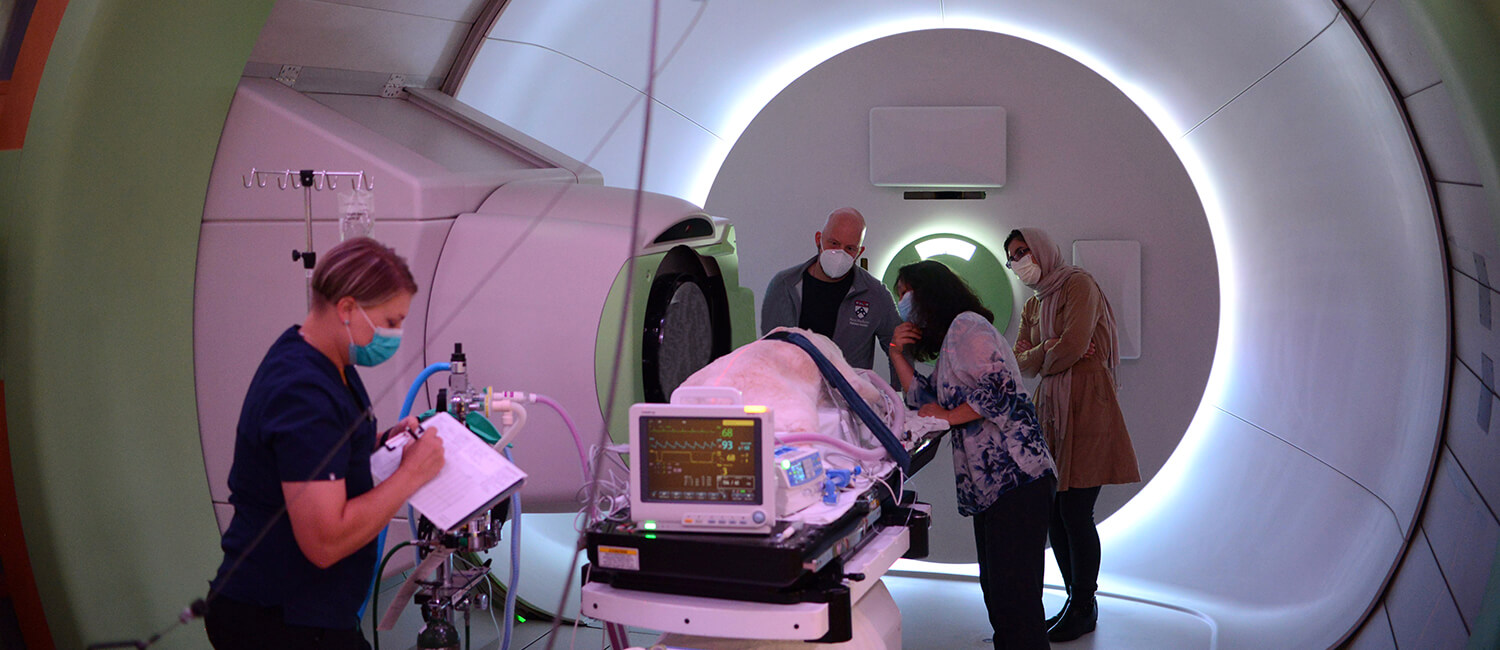 Experts from the Perelman School of Medicine and the School of Veterinary Medicine teamed up for a trial of FLASH radiation on dogs with oral cancer. The approach delivers a course of palliative radiation in fewer clinic visits than traditional regimens dictate. The trial’s first participant was Maple, a 13-year-old Labrador retriever.
Experts from the Perelman School of Medicine and the School of Veterinary Medicine teamed up for a trial of FLASH radiation on dogs with oral cancer. The approach delivers a course of palliative radiation in fewer clinic visits than traditional regimens dictate. The trial’s first participant was Maple, a 13-year-old Labrador retriever.
“She has an old soul. Everyone has always said that about her.”
So says Meg Ruller, the owner of Maple, a yellow Labrador retriever with undeniably soulful brown eyes. Born and bred for a life of service, in her early years, Maple worked alongside two children with autism. Later, she joined Ruller’s family, and under her care, Maple became a therapy dog, visiting the Ronald McDonald House to boost the spirits of children facing illness and their families.
“She’s just the best dog ever,” says Ruller, a 2018 School of Veterinary Medicine graduate who had trained Maple as a puppy. “She’s so sweet and mopey, I call her Eeyore.”
Today, 13-year-old Maple has cancer. But even in this, she’s helping others.
 Dr. Brian Flesner
Dr. Brian Flesner
Maple was the first patient to participate in a study of a novel approach to radiation therapy at Penn, led jointly by Keith Cengel, a radiation oncologist at the Perelman School of Medicine, and Brian Flesner, an oncologist at Penn Vet. The two have teamed up in an effort to advance cancer care for both people and pets.
Palliative radiation therapy can slow tumor growth and reduce pain, but typically requires treatments over several weeks or months. In contrast, the technique Cengel and Flesner are investigating, known as FLASH radiation, is—as the name indicates—far speedier. Patients can receive a palliative course of radiation in just a few visits. Following an initial study of the technique in dogs with osteosarcoma begun in 2019, this new trial is using a precisely directed proton beam to target smaller tumors of the oral cavity. The energy of the positively charged particles in the proton beam destroys cancer cells, while penetrating deeply into tissue. This therapy may also spare normal tissues that surround the tumor from being damaged, a “potentially game-changing” outcome, Flesner says.
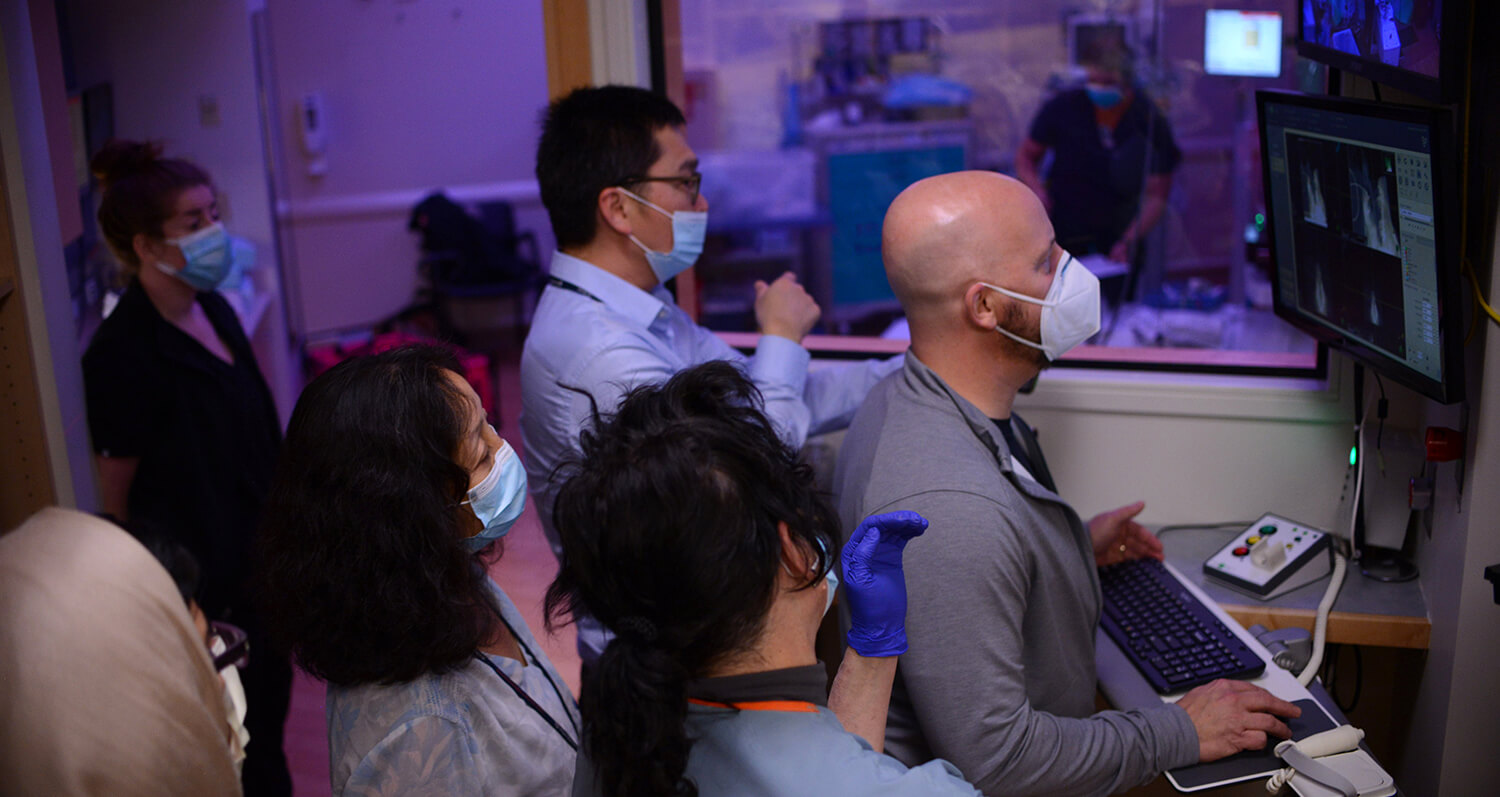 Keith Cengel from Penn Medicine (at computer) and Penn Vet’s Brian Flesner are leading the effort, collaborating with teams from both schools. Dogs in the trial receive their treatments at the Roberts Proton Therapy Center in the evening, once human patients have left.
Keith Cengel from Penn Medicine (at computer) and Penn Vet’s Brian Flesner are leading the effort, collaborating with teams from both schools. Dogs in the trial receive their treatments at the Roberts Proton Therapy Center in the evening, once human patients have left.
If the results prove promising in canine cancer patients, it may open the door to exploring the use of the technique in people, the researchers say. “We think FLASH is going to be safer and hopefully as efficacious as a standard radiation therapy,” says Flesner.
Dogs in the study receive treatment in the Roberts Proton Therapy Center at Penn Medicine in the evening, after human patients have left. Ultimately, the researchers hope to study nine dogs, gathering data on FLASH’s side effects and influence on disease. “It’s a great opportunity to potentially help dogs as we are learning more about how this works,” Cengel says.
Refining FLASH to expand applications
FLASH radiation is believed to cause less toxicity than traditional approaches due to the transient and highly precise nature of the radiation exposure. In the earlier study of dogs with osteosarcoma in their legs, led by Cengel and Penn Vet surgeon Jennifer Huck, standard-of-care involved amputation of the affected limb. In that trial, pets received FLASH radiation aimed at their tumor, then had the limb amputated five days later. The researchers could study the tumor after the fact.
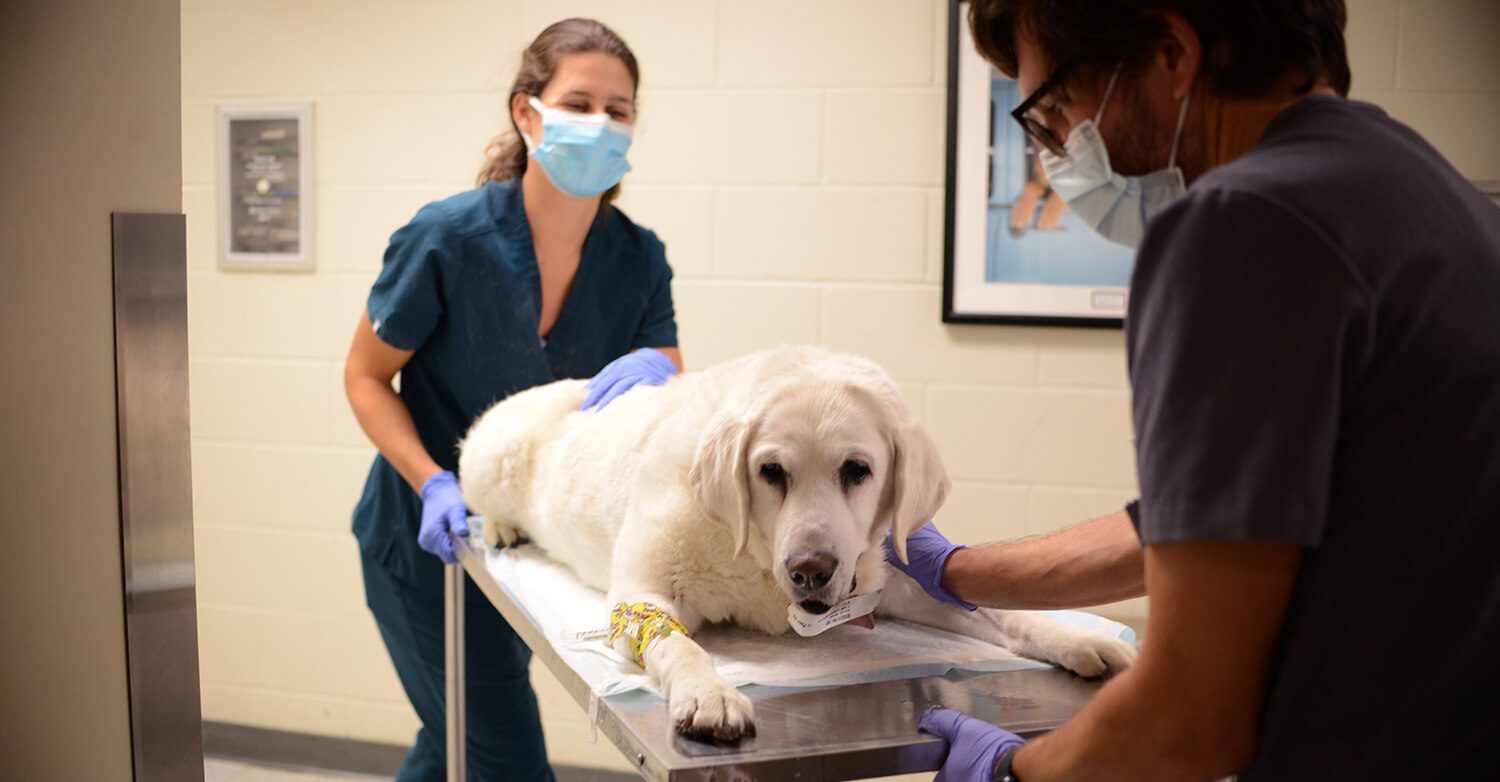 At a follow-up visit, June DiBona (left), the primary veterinary nurse for the trial, and vet tech Robert Cantagallo transport Maple to receive a CT scan that will help track the tumor’s response to the treatment.
At a follow-up visit, June DiBona (left), the primary veterinary nurse for the trial, and vet tech Robert Cantagallo transport Maple to receive a CT scan that will help track the tumor’s response to the treatment.
The new study, involving cancers of the oral cavity, increases the degree of technical difficulty, as the location of the tumors the clinicians are targeting means that the beam will penetrate healthy tissues on the way to reaching the cancerous tumor. To minimize side effects, Cengel, Flesner, and colleagues have worked closely and continuously with engineers to train the proton beam to precisely reach the desired tissue, no further.
Only dogs that meet certain requirements are eligible to enroll in the study. Pets must have disease for which surgery is not an option, and where radiation would be a form of palliative care, not a potential cure. The tumors also must have particular dimensions in order to be reached by the proton beam.
As opposed to the osteosarcoma study, the current investigation will enable researchers to monitor for longer term effects of FLASH on the tumor and surrounding tissues. “It will be easier for us to evaluate efficacy and tolerability with side effects,” says Flesner. “Some early data from the original trial indicates that FLASH reduces fibrosis and scar tissue signaling, but we don’t have those longer term outcomes that we hope to obtain.”
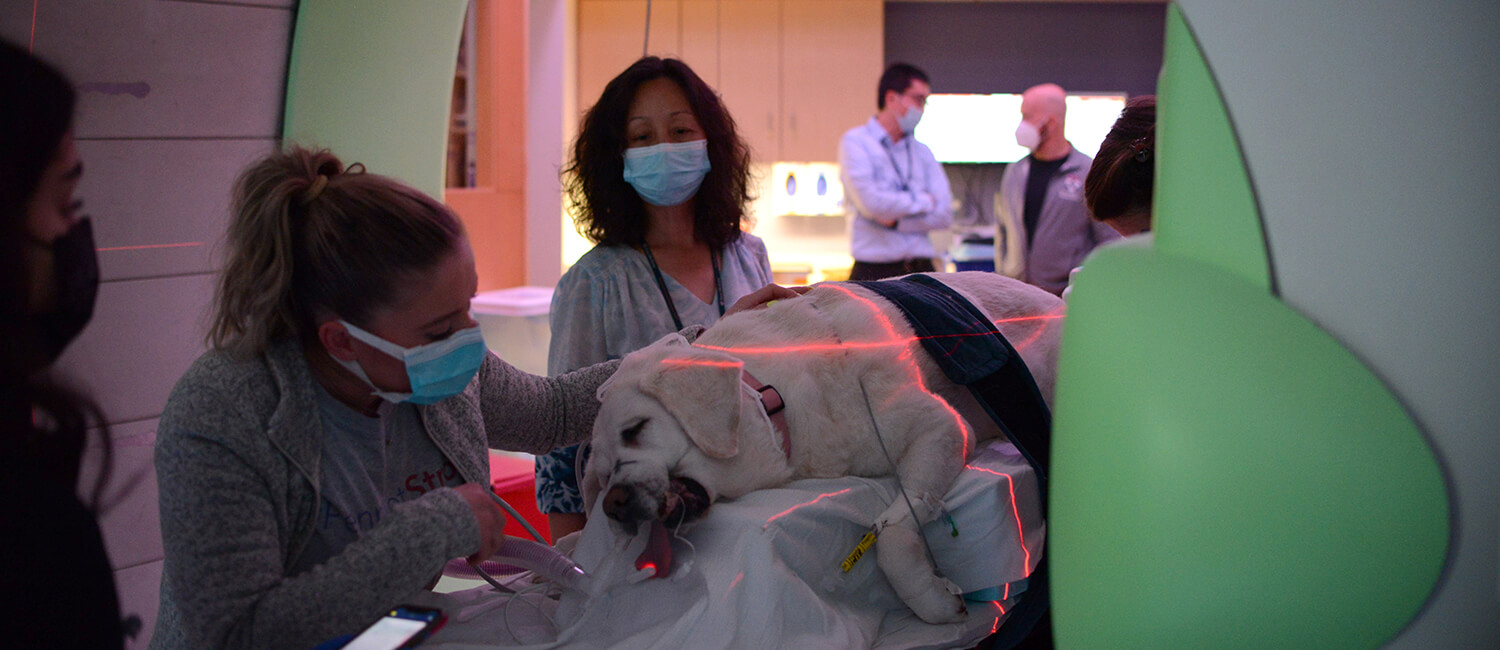 FLASH radiation may cause less irritation on tissues that surround the tumor. A large Penn team has worked with engineers to optimize and correctly position the proton beam, aiming for maximum efficacy and minimal side effects.
FLASH radiation may cause less irritation on tissues that surround the tumor. A large Penn team has worked with engineers to optimize and correctly position the proton beam, aiming for maximum efficacy and minimal side effects.
The trial is starting conservatively, giving dogs a low dose of radiation, separated into two treatments roughly a week apart. “The next iteration of this work would be to do a dose escalation in dogs,” Cengel says, finding the sweet spot of good efficacy with minimal side effects. The team also hopes to study the approach in cats, in different tumor types, and using electrons instead of protons, which don’t penetrate as deeply. Eventually the goal is to refine protocols for performing the technique in people with various types of cancer.
Though conducting the trial is expensive, with large teams required to run the proton beam as well as care for the patient, Cengel says he can foresee a time when technological costs will come down, making FLASH a more accessible option for clinical use, across human and veterinary radiation oncology.
“Right now the technology is difficult and very expensive, but that’s only because it’s new and fancy,” says Cengel. “Once we work with it more, I don’t see a reason why this won’t become more available.”
Maple in service
Ruller had noticed a mass in Maple’s mouth in late August. Reluctant to put her dog under anesthesia unnecessarily, Ruller kept an eye on it for a few weeks, until the growth began bleeding and seemed irritated. At that point, Ruller brought Maple into the clinic where she works in New York’s Hudson Valley and performed the surgery to remove it herself. “It came back as a maxillary osteosarcoma,” Ruller says. “It’s pretty uncommon.”
After consulting with a local specialist, Ruller ended up connecting with Flesner, who started at Penn Vet about a year ago, after Ruller had graduated. He familiarized her with a few clinical trials for which Maple could be eligible. The FLASH trial appealed to Ruller, in part because it involved the fewest visits and most flexibility for making the two-and-a-half hour trip from New York.
A few weeks later, Ruller was driving to Philadelphia with Maple, her partner, and another one of her dogs, a 12-year-old boxer named Champ. “I needed to have that dog energy around me,” she says.
Maple got the treatment, went home, then repeated the process several days later for the second dose. Following FLASH, “the tumor looked significantly less inflamed,” Ruller says, and Maple was feeling well enough to partake in a favorite activity—a swim in a local lake. Since then, the tumor began to grow and become irritated once again, prompting Flesner and Lillian Duda, a Penn Vet radiation oncologist and collaborator on the study, to recommend another dose of FLASH—all part of the learning process.
In early October, Maple returned to Penn Vet for a follow up CT scan. Veterinary technician June DiBona rolled Maple out the doors of Ryan Hospital in a hot pink wagon, where Ruller—and three of her other dogs—shared a happy reunion.
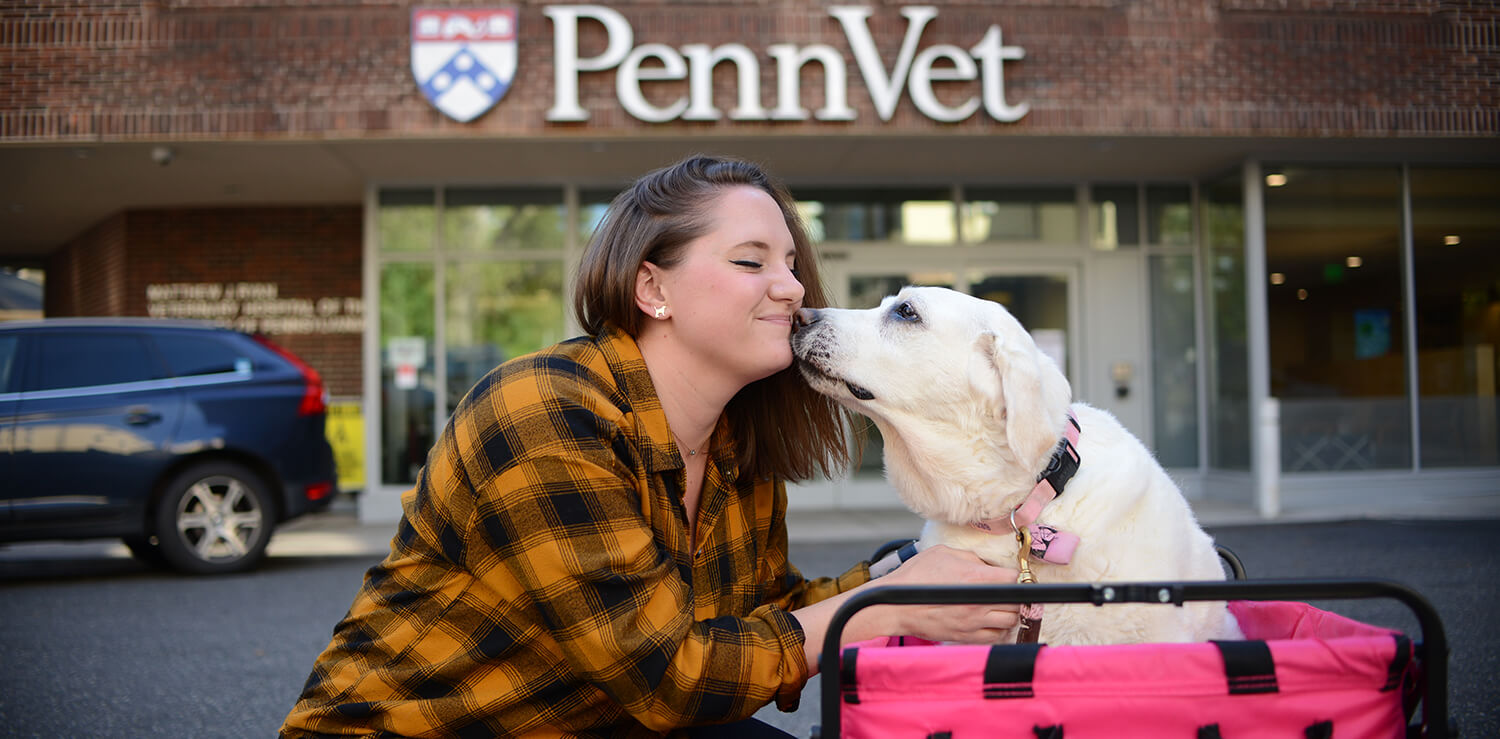 Meg Ruller, a 2018 graduate of the School of Veterinary Medicine, calls the FLASH trials “a fantastic opportunity” for Maple to receive a cutting-edge treatment—and to contribute to a scientific understanding of how FLASH radiation might help others in the future.
Meg Ruller, a 2018 graduate of the School of Veterinary Medicine, calls the FLASH trials “a fantastic opportunity” for Maple to receive a cutting-edge treatment—and to contribute to a scientific understanding of how FLASH radiation might help others in the future.
“Lots of people don’t know that there are clinical trials in veterinary medicine,” Ruller says. “This has been a fantastic opportunity for her. And being part of a clinical trial, for her, it’s kind of a full-circle moment. She’s been a service dog her whole life, so to be involved in something like this felt like the right move for her. I like the idea that she is still in service.”
Keith Cengel is a professor of radiation oncology at the University of Pennsylvania Perelman School of Medicine.
Brian Flesner is an associate professor of clinical oncology at Penn’s School of Veterinary Medicine.
Meg Ruller is a veterinarian at Middletown Veterinary Hospital in Middletown, New York, and a 2018 graduate of Penn’s School of Veterinary Medicine.
The study is supported by the Mark Foundation and IBA.